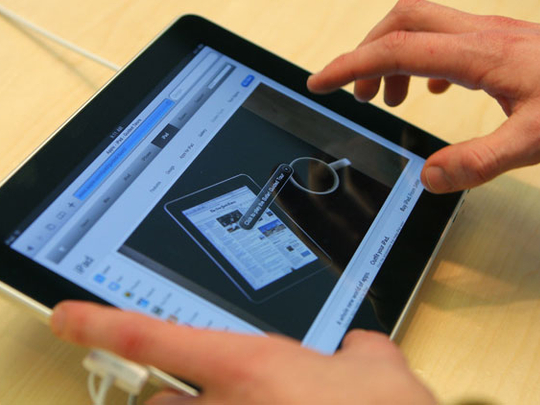
Apple Incorporated has largely pitched its new tablet computer as being all about consuming media in all its many forms. Books, games, movies, magazines — step right up, folks, we've got it all for you in one magical device!
But being revolutionary — Steve Jobs's word, not mine — requires a lot more than just building an e-book reader that provides a better experience than Amazon.com Incorporated's Kindle. The real promise of the iPad is that it has a chance to redefine what we think of as personal computing. And that has implications not just for Apple's own personal computing business but for Microsoft's, Google's and just about everyone else's.
For anyone looking for a new productivity tool, the 0.68 kilogram iPad offers a marriage of the always-on, always-connected, rapid-response of a wireless phone with the ultra-portability of a netbook and, through the vast array of applications that already run on it or are being written for it, the versatility of a laptop or even desktop PC.
"I think this is the new Mac, I really do," says Marc Benioff, the chairman and chief executive officer of Salesforce.com Incorporated. "People aren't going to want Macs any more. They're only going to want these devices. I think people won't want laptops any more once they see what's really possible on great tablets."
Seeing the potential
Many business people are seeing the same potential. More than half those surveyed recently by Zogby International said they would use a tablet device such as the iPad for working outside the office, according to software maker Sybase Incorporated, which commissioned the poll.
At $499 (Dh1,832) for the base model with Wi-Fi and Bluetooth, the iPad is in the same ball-park with netbooks, the underpowered miniature laptops that run Microsoft Windows. While the iPad has much less local storage — from 16 to 64 gigabytes of solid-state memory depending on the model, versus the 160-gigabyte hard drives found in many netbooks — it substitutes connectivity for capacity, which for mobile business users suggests the need for 3G service, adding $130 to the cost of the unit, plus $15 or $30 monthly for a data plan offered by AT&T Incorporated.
Microsoft and the makers of Windows PCs aren't the only ones who have to ponder the iPad's impact. Google Incorporated has to figure out what it means for the ambitions for its Web-centric Chrome operating system.
Netbook-like devices using Chrome should start appearing in significant numbers this year, and comparisons will be inevitable. We may be in for a repeat of the iPhone versus Android scuffle that's playing out in the wireless-phone market right now, with Apple pitting its polish and vast ecosystem of third-party add-ons against Google's efforts to make its software ubiquitous by giving it away free to all comers.
While the iPad runs most of the 150,000 applications already written for the iPhone and iPod Touch, its larger longer-term potential is visible in three sort-of new apps that Apple is introducing along with it. These are rewritten versions of the Mac's iWork office-software suite: Pages, a word processor; Numbers, a spreadsheet; and Keynote presentation software. Unlike the Mac version, where all three applications are bundled together for $79, you'll be able to buy them separately for $9.99 each.
Touch or type?
While the three have been re-engineered to take advantage of the iPad's touch-screen interface, that may not be the way many people choose to use them. On-screen typing in Pages, for instance, can be problematic because the shape and materials of the iPad's exterior leave it prone to sliding around on a smooth surface. It's a lot easier to use the device on your knees than on a tabletop.
There will be remedies, but they'll cost extra in terms of money and hassle. At the iPad launch event, Jobs showed off a new combination keyboard and docking station that holds the iPad at a good angle for typing. That's another $69, and it isn't shipping for a month. Bluetooth keyboards will work with it, too; both raise questions about users' willingness to lug them around.
It's worth remembering that it took a while for both of Apple's most recent game-changing devices to find their eventual niches. The iPod, introduced in 2001, didn't graduate from a nice music player to a cultural phenomenon until the arrival of the iTunes Music Store in 2003. The iPhone was an immediate hit when it went on sale in 2007, but its full potential wasn't unlocked until the next year, when Apple allowed developers to write applications that would run natively under its operating system.
So we can't assume that the way the iPad is used today is the way it will be used tomorrow. Maybe it really does just turn out to be a cool way to read The Girl With the Dragon Tattoo, watch The Hurt Locker and play Need for Speed. But there's a fair chance it will turn out to be more. Much, much more.












